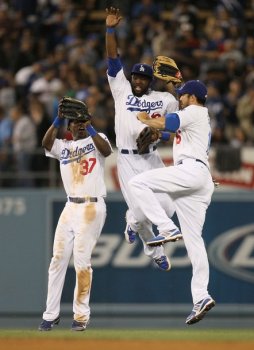With the All-Star game right around the corner, we’re almost to the unofficial halfway point of the baseball season. As with any given year, the first half of baseball has given us plenty of thrilling moments, introduced us to some exciting young players, and produced some incredible storylines. The Los Angeles Dodgers are one of those storylines, leading all of baseball in wins even with their best player — and one of the best overall players in baseball — out of action.
Who needs Matt Kemp when you have the likes of A.J. Ellis (.302/.433/.462. 6 HR), Elian Herrera (.296/.395/.38), and Jerry Hairston (.333/.427/.444) coming up huge? And how about the pitching staff that was seemingly duct taped together with bargain bin veterans? Aaron Harang (3.59 ERA) and Chris Capuano (2.87 ERA), both signed two-year deals, Harang for an average of $6M per season and Capuano for an average of $5M per season. However, in the case of both pitchers, their K/BB ratios are right around league average, which suggests that they might not be able to maintain their current level of performance. Harang is more likely to continue with his comeback season, given his move away from Great American Ballpark and into the expansive fences of Dodger Stadium. His HR/9 has dropped and he’s striking out about one more hitter per nine innings than he did last season. Capuano is still allowing over one home run per nine innings pitched, but he is also striking out almost eight batters per nine innings and has managed to strand 80 percent of his baserunners. That strand rate is about seven percent above the league average and his career average, which means that a regression is very possible and there is a good chance more of his baserunners allowed will come in to score in the second half.
Even if Harang and Caupano regress, they still have arguably the best pitcher in baseball and a still young Chad Billingsley, who is amid a bounce-back year of his own after posting a 4.21 ERA and 4.14 xFIP last season. Billingsley has lowered his walk rate a bit and increased his strikeout rate a bit while generating swings and misses at around his career rate.
The bullpen has held it's own thus far, led by strikeout artist Kenley Jansen and backed up by the veteran Matt Guerrier. Though their bullpen has the second lowest ERA in the National League (3.15), their is a large disparity between that ERA and their bullpen xFIP of 3.90. Though the small sample size for relievers can lead to anomalies over a full season, there is more than a little risk that the bullpen won't aid in as many wins going forward.
The ingredients are in place for this team to remain in contention, especially in the NL West, but before long, some of their current surprise players – Bobby Abreu with his .415 BABIP fueled .305/.421 line along with Herrera and Hairston – will come back down to earth. Even Kemp, before hitting the DL, had peripheral stats that suggested his torrid pace would slow (.383 BABIP, 40-percent HR/FB rate).
If the Dodgers lineup can continue to show excellent plate discipline – they lead the National League in team walk rate and team OBP – they have a god chance of fending off a major decline even when some of the current hot hitters come back down to earth. Make no doubt about it, the Dodgers are not as good as their record indicates, but they still have a sound chance to win the division.
Photo courtesy of Daylife.com

